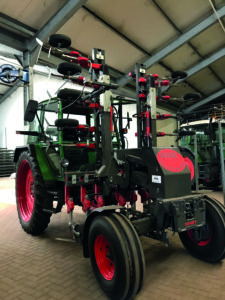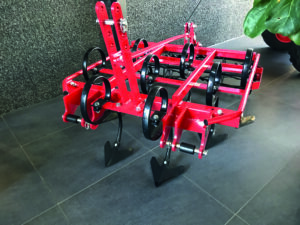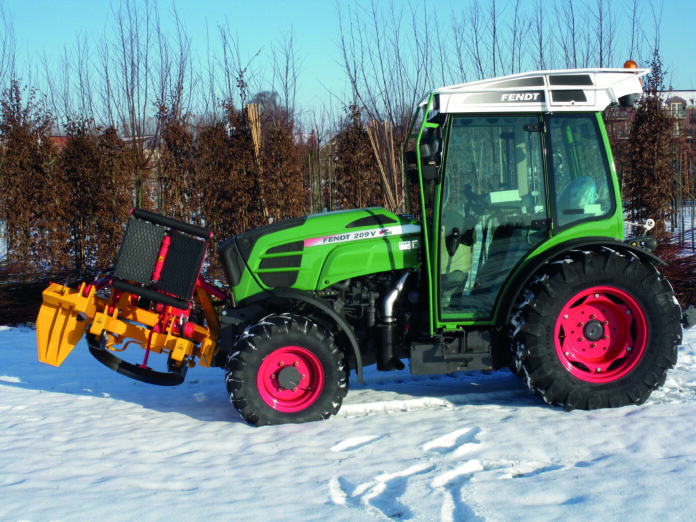The tree nursery sector in Ireland has been developing over many years. It has the characteristics of a modern, technical industry, competing at the highest quality level with any imports. Our mild climate has its benefits in terms of winter-long harvesting, and being on an island has helped to isolate us from some damaging pests. The sector is diverse and has encouraged specialism: growing young whips in seedbeds, rootstocks, transplants, maidens and finished specimen trees. The technology in this sector is evolving rapidly with trends in robotics, autonomous driving, weed control and electrification. With its peak harvest during the winter, work conditions in the tree nursery sector can be cold, wet and long. The incentive for growers to automate is four-fold: to replace employees that are leaving the sector; to increase productivity; to improve the quality of the stock lifted; and to reduce hardship for employees.
There is strong interest in replacing the diminishing chemical weed control options with innovative mechanical tools
Native Irish hedge production has seen peaks with farming schemes such as the Green Low-Carbon Environmental Scheme (GLAS), the Results-Based Environment-Agri Pilot Project (REAPS), and the Agri-Climate Rural Environment Scheme (ACRES). Hedging whips can now be produced by the millions with the use of some impressive machinery. Irish nurseries have for some time been using precision seeders from the likes of Egedal that ensure exact planting densities and depths, resulting in uniform seedbeds. Transplanting with specialist machines increases efficiency and limits ‘J root’ rejects.
HARVESTING, PLANTING & LIFTING
Harvesting has recently taken a significant jump forward. Dutch manufacturer SMZ design and manufacture seedbed-lifting equipment for whip and young tree production.
While we have not been blessed with the flat, stone-free fields that Dutch and Belgian growers are accustomed to, SMZ have developed equipment that is suited to Irish conditions. I spoke to SMZ Company owner Wilfried Schrauwen. He explained how SMZ can adapt any of their machines for a grower’s unique set-up, even in Ireland, where stones and slope are a challenge for growing and harvesting. Kilcavan Nursery based in Wicklow specialises in growing beech and blackthorn hedging. They have recently started using an SMZ bed-lifter. Co-owner Eamonn Doyle says it has transformed their business.

“We used to harvest with 14 people in the field; now we only need four. It’s allowing us much greater flexibility to work with the short weather windows we have.” According to Eamonn, the challenges of recruiting people to harvest in the middle of winter had been holding back the business.
Eamonn’s son, Pierce, who also works in the nursery, was very keen to take on more technology to make production more efficient.
“We have invested in some planting equipment with auto-steer (GPS assisted) for a tractor, again to reduce the need for labour that we can’t find,” says Pierce. This system has saved on finding another person for this operation, as the driver can now do other work as well as driving, such as straightening plants, getting boxes and so on.

Basrij in Zundert, the Netherlands, are specialists in planting equipment and are widely used by hedge and field strawberry growers. Like SMZ, they have a can-do attitude and are happy to work with Irish growers to provide solutions for their specific needs.
Tree lifting equipment, either for rootball or bareroot, is essential for production of quality trees. In Ireland, Damcon are the most well-known brand of machines in the semi-mature tree production sector, with MDE and Pizagli also well-regarded. They all offer self-propelled or tractor-mounted tree-lifting equipment. The reliability of these machines can be indispensable when weather windows are short. Trends see Irish growers looking to bigger, more flexible machines able to lift a wider range of tree sizes more efficiently.

Leen Scheurwater is an enthusiastic manager of Damcon. Leen has an immense interest in the equipment the company sells, and often recalls each customer and item purchased, even in Ireland. The workshop designs, spray paints and assembles all of their own equipment, with laser cutting of metal work carried out by other specialists. Damcon are agents of well regarded equipment such as Pizagli, Norcar and Clemens. Kubota engines are their preferred choice for their machines, for reasons of reliability and availability of parts.
John Joe Hyland, who owns and runs a hedging nursery in Wexford, has been using a Damcon tree spade for lifting hedging for a few seasons. According to John Joe, “It’s a fantastic machine, I’d highly recommend it. It’s saved us alot of time in lifting and has helped keep our productivity up after losing some employees.”
MDE Machinebouw in the Netherlands are specialist equipment manufacturers of planting, rootballing, mobile tree platform and tree lifting machinery. They are considered by some growers to make the most robust tree-lifting equipment on the market.
TRACTOR POWER & HIGH CLEARANCE
For tractor power, the Dutch nursery sector has widely adopted the Fendt 200 Vario from the orchard and vineyard sectors. These very compact tractors are as narrow as 1.07m and have horsepower up to 114. Again, Irish growers are capitalising on observing Dutch experiences, and are beginning to make investments in these high-tech labour-saving machines. RTK GPS (real-time kinematic global positioning system) and cat 4 air filter protection are essential added features that deliver precise manoeuvrability and ease of operator use for activities such as spraying.

Lommers machinery have developed a range of unique machines, including high-clearance versions, that run over the top of field-grown hedging. These multi-function machines straddle the field-grown plants and can plant, prune and lift them. The development of these machines has helped deliver the consistent high-quality plants being produced from Belgium, the Netherlands and further afield.
These machines’ efficiency, often guided by RTK GPS, helps to limit labour requirements.
Toine Lommers – owner and founder of the Lommers company – says that self-propelled tracked and wheeled machines can work very precisely and limit compaction on the soil. It is exciting to see the first of these machines in Ireland due to land this winter, to be put to use by nurseryman, Colin Delaney.
“It should be a great addition,” Colin says, “but like any machine, it’s going to take a bit of time to get used to.” Colin notes that the machinery manufacturers in the Netherlands weren’t fazed by any challenges he put to them about Irish conditions, and were always happy to find solutions.
Other high clearance specialist tractors dedicated to small tree and hedge production include those produced by OC Group in the Netherlands, such as their High Clearance Trac tractor, which can carry a range of mechanical hoeing equipment.
WEEDING & ELECTRIC APPEAL
There is strong interest in replacing the diminishing chemical weed control options with innovative mechanical tools. This was evident at many machinery events held last summer, such as Baumschuletechnik in Germany, and mechanical weeding demo days in fruit in the Netherlands by LTO (a business organisation for Dutch farmers and gardeners), and in vegetables by Teagasc in Oak Park, Co Carlow. Technical weeding advances are in part driven by growth in the organic veg sector.
A few Irish tree growers have used Clemens mechanical weeders in recent years with varying degrees of success. This equipment was pioneered for the vineyard industry but has made a transition into tree production. The rotary finger weeders are made from plastic tines that vary in density (and colour) to suit the soil type and crop. One of the latest innovations is a mechanical inter-row rotary weeder called Weedelete by Van Tuijl. It has a collar around the blade/tines preventing it hitting the stems of young trees or drip irrigation.
Other manufacturers supplying mechanical weeders include two notable German companies, ALM (who make mulchers and rotary hoes), and Feldklasse, who have developed a hoeing machine for 1+0 tree seedlings. A word of caution though, as any physical damage caused to tree stems while weeding can result in damaged, unsaleable stock.
Electric equipment is increasingly popular, too, for a number of reasons. Items such as electric working platforms and handheld pruning equipment are favoured by field workers due to reduced vibrations and exhaust fumes. (As mentioned already, worker comfort and happiness impacts retention.) The reduction of the carbon footprint of this equipment is a bonus too, as companies increasingly have their own power generation on-site with solar arrays.
Technology adoption will continue to be a key trend for the tree nursery sector, with a need to apply technical solutions to emerging problems in the horticultural business model, targeting inputs such as labour efficiency. There will be continued investment by growers and producers in leading-edge technology, such as increased automation and precision engineering. ✽
 Dónall Flanagan is a nursery stock/ornamentals specialised advisor working with the Teagasc Horticulture Development Department in Ashtown, Dublin 15. He recently guided a group of Irish nursery growers on a study tour of tree and hedge-growing businesses in the Netherlands. Contact: 087 703 5823, 076 111 4021, donall.flanagan@teagasc.ie.
Dónall Flanagan is a nursery stock/ornamentals specialised advisor working with the Teagasc Horticulture Development Department in Ashtown, Dublin 15. He recently guided a group of Irish nursery growers on a study tour of tree and hedge-growing businesses in the Netherlands. Contact: 087 703 5823, 076 111 4021, donall.flanagan@teagasc.ie.







